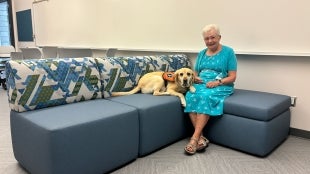Cal Poly CubeSat Team Helps With Deep Space Exploration

Cal Poly engineering students work on a CubeSat in PolySat, the student-run campus research lab. (Photo taken in 2019 before the COVID-19 pandemic.)
As members of The Planetary Society celebrated a benchmark development in space exploration last summer, a life-sized cardboard cutout a few feet away served to remind them of Cal Poly’s major contribution to the event.
That cutout, located in Cal Poly’s CubeSat Lab, depicts retired Cal Poly professor Jordi Puig-Suari, who co-created a mini-satellite called a CubeSat, which has greatly expanded space research. While Puig-Suari was sailing the world with his wife and son when The Planetary Society’s CubeSat, LightSail 2, successfully deployed its solar sail in space, Puig-Suari was aware of the momentous event circling some 450 miles above the Earth.
“It is a huge score for CubeSats and for the team at Cal Poly,” he said. “It is the beginning of a new way to travel in space.”
It is a huge score for CubeSats and for the team at Cal Poly. It is the beginning of a new way to travel in space.
Jordi Puig-Suari
Retired Cal Poly Aerospace Engineering Professor and CUBESAT Co-Creator
A year after Cal Poly served as mission control for the solar sail deployment, which allowed the LightSail 2 to propel through space, the university’s contributions to space research continue, most visibly with Victor Glover (General Engineering, ’99), a NASA astronaut who is expected to head to the International Space Station in late September. Meanwhile, the university announced a partnership between the Air Force Research Laboratory and the Aerospace Engineering Department that will direct $2.5 million to further propel Cal Poly’s groundbreaking mini-satellite program.
Since Puig-Suari developed the CubeSat standard with former Stanford University professor Bob Twiggs in 1999 — to give students the opportunity to design, build and launch small satellites into space — scores of private businesses, schools and governments have created their own CubeSats, leading to an explosion of space research and innovation.
Like the Dragon spacecraft Glover will travel in, CubeSats are launched into space via rockets. But once released, the bread-loaf-sized CubeSats have aimlessly floated in space. The Planetary Society, led by celebrity scientist Bill Nye, achieved a significant development last summer by proving that CubeSats with a solar sail can travel through space propelled by photons from the sun.
“For me it’s very romantic that you’d be sailing on sunbeams,” Nye told a crowd gathered across from the CubeSat lab via a live video connection.

With the ability to propel through space — with no concern about fuel — CubeSats will be able to travel farther, going where no satellite has gone before.
“Solar sailing excites me because it enables us to build small spacecraft that can explore our solar system,” said John Bellardo, a Cal Poly computer science professor who was part of the mission control team that sent radio commands from Cal Poly’s ground station to the LightSail 2.
The solar sail concept was discussed in the 1970s by The Planetary Society founder Carl Sagan.
“The community spent decades talking about solar sailing as an academic exercise,” said Puig-Suari, a former aerospace engineering faculty member, after the success of LightSail 2. “Carl Sagan would be proud!”
LightSail 2 was prepared at Cal Poly, and the team included Bellardo, who directs Cal Poly’s CubeSat Lab, and Cal Poly physics major Michael Fernandez, PolySat’s systems engineer.
This June, a year after LightSail 2’s launch, The Planetary Society announced that LightSail 2 had completed its primary mission phase but would continue to help researchers learn more about solar sailing in an extended mission. Meanwhile, Cal Poly — which has created nearly a dozen mini-satellites launched into space — currently has three more in the works. And the U.S. Air Force partnership seeks to further CubeSat propulsion.
“CubeSat technology has really progressed over the past 20 years,” said Robert Crockett, associate dean for innovation infrastructure at Cal Poly’s College of Engineering. “Helping to advance propulsion will help us maintain a leadership role.”




